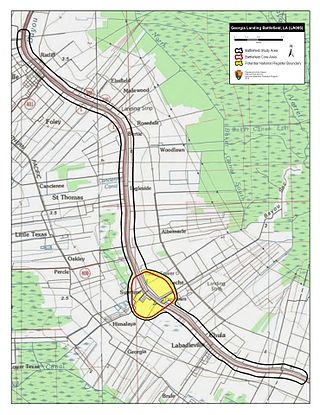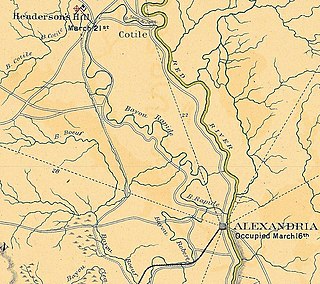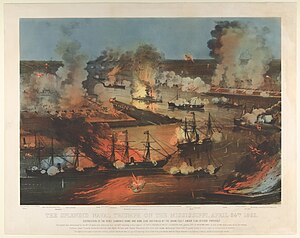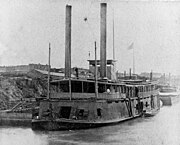
The third USS Lexington was a timberclad gunboat in the United States Navy during the American Civil War.

The Battle of Port Gibson was fought between a Union Army commanded by Major General Ulysses S. Grant and a reinforced Confederate States Army division led by Major General John S. Bowen. Though the outnumbered Confederate soldiers fought stubbornly, they were steadily pressed back during the day by Major General John A. McClernand's troops. Bowen eventually conceded the field by withdrawing north toward Vicksburg, Mississippi. The battle occurred near Port Gibson, Mississippi, during the Vicksburg Campaign of the American Civil War.

The Battle of Irish Bend, also known as Nerson's Woods or Franklin, took place during the American Civil War. It was fought between Union Major General Nathaniel Prentice Banks against Confederate Major General Richard Taylor during Banks's operations against the Bayou Teche region near Franklin, the seat of St. Mary Parish in southern Louisiana.

The Battle of Blair's Landing saw a Confederate cavalry-artillery force commanded by Brigadier General Tom Green attack several Union gunboats led by Rear Admiral David Dixon Porter and soldiers in river transports under Brigadier General Thomas Kilby Smith in Red River Parish, Louisiana. Green's force attempted but failed to stop the retreat of Porter's and Smith's forces downstream in an action that was part of the Red River Campaign of the American Civil War. The only significant casualty during the fighting was Green, who was killed by an artillery round.

The Battle of Yellow Bayou, also known as the Battle of Norwood's Plantation, saw Union Army forces led by Brigadier General Joseph A. Mower clash with Confederate States Army troops commanded by Brigadier General John A. Wharton in Avoyelles Parish, Louisiana during the American Civil War. This was the final action of the Red River campaign in which a Union army under Major General Nathaniel P. Banks was repulsed by Confederate forces led by Major General Richard Taylor. The failed Union campaign almost ended in disaster when an accompanying Union fleet led by Rear Admiral David Dixon Porter was trapped at Alexandria, Louisiana, by low water in the Red River. An engineering feat saved the fleet, allowing Banks' army to complete its withdrawal.

The Battle of Georgia Landing or Battle of Labadieville was fought between a Union Army force led by Brigadier General Godfrey Weitzel and a Confederate States Army force commanded by Brigadier General Alfred Mouton near Labadieville, Assumption Parish, Louisiana, during the American Civil War. After a sharp clash, the Union troops compelled Mouton's outnumbered force to retreat.

The 1st Missouri Field Battery was a field artillery battery that served in the Confederate States Army during the American Civil War. The battery was formed by Captain Westley F. Roberts in Arkansas in September 1862 as Roberts' Missouri Battery and was originally armed with two 12-pounder James rifles and two 6-pounder smoothbore guns. The unit fought in the Battle of Prairie Grove on December 7, as part of a Confederate offensive. Roberts' Battery withdrew after the battle and transferred to Little Rock, Arkansas, where Roberts resigned and was replaced by Lieutenant Samuel T. Ruffner.

The 18th Texas Infantry Regiment was a unit of volunteers recruited in Texas that fought in the Confederate States Army during the American Civil War. The regiment was enrolled in Confederate service in May 1862 and always campaigned west of the Mississippi River in the region known as the Trans-Mississippi Department. The unit was assigned to the Texas infantry division known as Walker's Greyhounds. The regiment fought at Milliken's Bend, Richmond (La.), and Bayou Bourbeux in 1863 and Mansfield, Pleasant Hill, and Jenkins' Ferry in 1864. The regiment disbanded in mid-May 1865, but its formal surrender date was 26 May 1865.

The Battle of Henderson's Hill or Bayou Rapides saw a reinforced Union Army division led by Brigadier General Joseph A. Mower opposed by a regiment of Confederate Army cavalry and attached artillery under Colonel William G. Vincent. That evening, during a rainstorm, Mower sent one infantry brigade on a circuitous march to gain the rear of Vincent's command. The brigade's subsequent attack surprised and captured most of the Confederates. Mower could not exploit his minor victory because the arrival of additional Federal army and naval units was delayed. This clash occurred during the Red River campaign of the American Civil War which saw Major General Nathaniel P. Banks' Union army try to seize Shreveport, Louisiana, from its Confederate defenders led by Lieutenant General Richard Taylor.

1st Texas Field Battery or Edgar's Company was an artillery battery from Texas that served in the Confederate States Army during the American Civil War. The artillery company formed in November 1860, but was not formally taken into Confederate service until April 1861. The unit participated in the disarming and surrender of United States soldiers and property in Texas in early 1861. The battery marched to Arkansas where in 1862 it joined the infantry division known as Walker's Greyhounds. The battery fought at Milliken's Bend and Richmond (La.), shelled a Federal river transport, and campaigned in south Louisiana in late 1863. The 1st Texas Battery was captured at Henderson's Hill in March 1864. The soldiers were later exchanged, and the unit disbanded in 1865 at the end of the conflict.

The 2nd Louisiana Cavalry Regiment was a unit of mounted volunteers recruited in Louisiana that fought in the Confederate States Army during the American Civil War. Breazeale's Cavalry Battalion was formed in July 1862 and was augmented by five additional companies in September 1862 to form a regiment. It served for the entire war west of the Mississippi River in the Trans-Mississippi Department. The regiment fought at Georgia Landing, Fort Bisland, Irish Bend, and Brashear City in 1863 and Henderson's Hill and Mansfield in 1864. Afterward, the regiment fought in minor skirmishes before the Trans-Mississippi's final surrender on 26 May 1865.

The 12th Louisiana Infantry Regiment was a unit of volunteers recruited in Louisiana that fought in the Confederate States Army during the American Civil War. Formed in August 1861, the regiment served in the Western Theater of the American Civil War and was unique in that there were 12 companies. The regiment garrisoned Island Number Ten before being stationed at Fort Pillow. It fought at Second Corinth in 1862 and Champion Hill and Jackson in 1863. A detachment served during the Siege of Vicksburg and was captured. In 1864, the regiment fought in the Meridian, Atlanta, and Franklin–Nashville campaigns, suffering heavy losses at Peachtree Creek and Franklin. It fought at Bentonville in 1865 before surrendering with General Joseph E. Johnston.

The 4th Louisiana Infantry Regiment was a unit of volunteers recruited in Louisiana that fought in the Confederate States Army during the American Civil War. Formed in May 1861, the regiment served in the Western Theater of the American Civil War. The unit fought at Shiloh and Baton Rouge in 1862 and at Jackson in 1863. A detachment served during the Siege of Port Hudson and was captured. In 1864, the regiment fought in the Atlanta campaign where it lost heavily at Jonesborough. At Nashville in December 1864 most of the men were captured. The survivors were consolidated with several other units and fought at Spanish Fort in April 1865. The remnant surrendered in May 1865.

The 23rd Louisiana Infantry Regiment was a unit of volunteers recruited in Louisiana that fought in the Confederate States Army during the American Civil War. The regiment organized in January 1862 at New Orleans by merging the Orleans Artillery Battalion, a state militia unit, with six independent companies. In March 1862, the unit mustered into Confederate service with 841 men and served during the war in the Western Theater of the American Civil War. The various companies were allocated to defend various forts. One company was assigned to hold Fort Jackson, fought in the Battle of Forts Jackson and St. Philip, and surrendered when the fort fell. After the Capture of New Orleans most of the companies disbanded. However, four companies reorganized at Camp Moore in May 1862 and traveled to Vicksburg, Mississippi where they manned the river batteries. In early 1863, the regiment was renamed the 22nd Louisiana Infantry Regiment. The soldiers went to Fort Pemberton where they helped drive off the Yazoo Pass expedition. The regiment was part of the garrison during the Siege of Vicksburg and was captured and paroled when the city fell in July 1863. The men reported to a parole camp. In January 1864, it and the remnants of six other Louisiana regiments were absorbed into the 22nd Consolidated Louisiana Infantry Regiment. This unit fought at Spanish Fort in March and April 1865 and surrendered at Meridian, Mississippi in May 1865.

The 1st Louisiana Regular Battery was an artillery unit recruited from volunteers in Louisiana that fought in the Confederate States Army during the American Civil War. The battery was accepted into Confederate service in October 1861. The battery fought at Baton Rouge in August 1862, then it transferred to the west bank of the Mississippi River and fought at Georgia Landing in October. In 1863, it fought at Fort Bisland and Vermilion Bayou. The battery was attached to Tom Green's Texas cavalry brigade for the remainder of the year and fought at Second Donaldsonville. In 1864, the battery did not come into action at Mansfield and Pleasant Hill, but it fought at Mansura and Yellow Bayou. The battery was at Tyler, Texas, at the end of the conflict.
The following is the organization of the Confederate forces engaged in the Red River campaign, during the American Civil War in 1864. Order of battle shows the army organization during the campaign. The Union order of battle is listed separately.
The 3rd Louisiana Field Battery was an artillery unit recruited from volunteers in Louisiana that fought in the Confederate States Army during the American Civil War. The battery organized in March or April 1862 at Monroe, Louisiana. It was nicknamed the "Bell Battery" because the cannons it was supposed to use were cast from bells donated by plantation owners. However, those guns never joined the battery and it received four different cannons. On 10–11 May 1863, the battery fought Union gunboats while part of the garrison of Fort Beauregard. In 1864, it served during the Red River campaign and was present, but not engaged at the battles of Mansfield and Pleasant Hill. The battery dueled with two Union gunboats at DeLoach Bluff on 26 April. After a skirmish on 6 May at Polk's Bridge, three of the battery's four guns became disabled. The soldiers ended the war while manning heavy cannons at Grand Ecore near Natchitoches, Louisiana, and where they surrendered in June 1865. A total of 108 men served in the battery during the war.
The 5th Louisiana Field Battery was an artillery unit recruited from volunteers in Louisiana that fought in the Confederate States Army during the American Civil War. The Pelican Artillery organized on 31 October 1862, recruiting men mostly from St. James Parish, Louisiana. The battery first saw action in November 1862 against Union gunboats on Bayou Teche. In April 1863, the unit distinguished itself at Fort Bisland and it fought a skirmish at Vermilion Bayou a few days later. In July 1863, the battery fired on Federal shipping at Gaudet's Plantation near Donaldsonville, Louisiana, and fought at Kock's Plantation. In April 1864, it served during the Red River campaign and was present, but not engaged at the battles of Mansfield and Pleasant Hill. In May 1864, the unit was engaged at Mansura and Yellow Bayou. The battery surrendered in early June 1865 while at Tyler, Texas. A total of 183 men enlisted in the battery during the war; 2 were killed in action, 5 died from disease, and 1 drowned.

The Actions near Alexandria saw a Confederate States Army force commanded by Major General Richard Taylor surround a greatly superior Union Army led by Major General Nathaniel P. Banks and a United States Navy flotilla commanded by Rear Admiral David Dixon Porter at Alexandria, Louisiana. Porter's gunboats were trapped above the double falls in the Red River by low water. Banks' army was compelled to halt its retreat to keep Porter's vessels from being scuttled or from falling into Confederate hands.

The Action of April 26–27, 1864 saw a Confederate States Army force led by Lieutenant Colonel John H. Caudle and Captain Florian Cornay ambush several Union Navy warships and auxiliary vessels commanded by Rear Admiral David Dixon Porter as they made their way downstream on the Red River of the South. Eleven days earlier, a Confederate naval mine sank a Union ironclad warship. The vessel was refloated and escorted downstream by Porter with five Union vessels, but on April 26 the ironclad had to be scuttled.


















